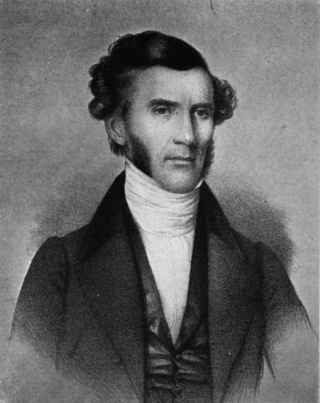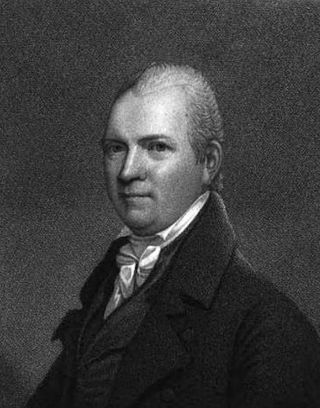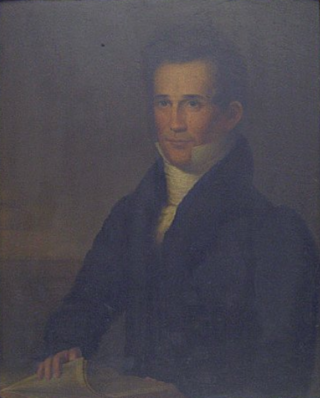
Ithiel Town was an American architect and civil engineer. One of the first generation of professional architects in the United States, Town made significant contributions to American architecture in the first half of the 19th century. His work, in the Federal and revivalist Greek and Gothic revival architectural styles, was influential and widely copied.

Henry Duncan FRSE was a Scottish minister, geologist and social reformer. The minister of Ruthwell in Dumfriesshire, he founded the world's first mutual savings bank that would eventually form part of the Trustee Savings Bank. He served as Moderator of the General Assembly of the Church of Scotland in 1839. At the Disruption has left the Church of Scotland and sided with the Free Church. He was also a publisher, a philanthropist and an author, writing novels as well as works of science and religion.

William Buell Sprague was an American Congregational and Presbyterian clergyman and compiler of Annals of the American Pulpit, a comprehensive biographical dictionary of the leading American Protestant Christian ministers who died before 1850.

Beriah Green Jr. was an American reformer, abolitionist, temperance advocate, college professor, minister, and head of the Oneida Institute. He was "consumed totally by his abolitionist views". Former student Alexander Crummell described him as a "bluff, kind-hearted man," a "master-thinker". Modern scholars have described him as "cantankerous", "caustic, belligerent, [and] suspicious". "He was so firmly convinced of his opinions and so uncompromising that he aroused hostility all about him."

Elias Cornelius (1794–1832) was an American Christian missionary and ordained minister.

James Waddel Alexander was an American Presbyterian minister and theologian who followed in the footsteps of his father, Rev. Archibald Alexander.

Andrew Wylie was an American academic and theologian, who was president of Jefferson College (1811–1816) and Washington College (1816–1828) before becoming the first president of Indiana University (1829–1851).

Samuel Miller was a Presbyterian theologian who taught at Princeton Theological Seminary.

William Patterson Alexander was an American missionary to the Kingdom of Hawaii. His family continued to influence the history of Hawaii.
West Presbyterian Church was a congregation and two houses of worship in Manhattan, New York City. The congregation was founded in 1829 and merged in 1911 with Park Presbyterian Church to form West-Park Presbyterian Church. The first house of worship, also known as the Carmine Street Presbyterian Church, in Greenwich Village, was used from 1832 to 1865, and the second, on West 42nd Street between Fifth Avenue and Sixth Avenue, from 1865 until 1911, when it was sold and demolished. Proceeds from the sale were used, in accordance with the merger agreement, to build and endow a church for an underserved neighborhood, Washington Heights: Fort Washington Presbyterian Church. In addition, the West Church congregation had earlier established two mission churches which eventually merged to become Good Shepherd-Faith Presbyterian Church. West-Park, Fort Washington, and Good Shepherd-Faith are all active today.

George Addison Baxter was an educator, American university administrator, theologian and author. He served as President of Washington and Lee University from 1799 to 1829 and Hampden–Sydney College from 1835 until his death.

James B. Abercrombie (1758–1841) was an American priest in St. Peter's Episcopal Church in Philadelphia. Having lost his father at a very young age, Abercrombie was subsequently raised and educated by his devoutly religious mother who encouraged him to become a minister, to which he readily aspired and became.

First Presbyterian Church in Schenectady, New York is a historic Presbyterian Church in America congregation.

Daniel Lynn Carroll was the sixth President of Hampden–Sydney College from 1835 to 1838.

John Mitchell Mason was an American preacher and theologian who was Provost of Columbia College in the early 1810s, and briefly President of Dickinson College in Carlisle, Pennsylvania in the early 1820s.
Jane C. Bonar was a Scottish hymnwriter. Her hymn, "Pass away, earthly joy!", first appeared in 1843 in Songs for the Wilderness. Two years after, it reappeared in The Bible Hymn Book, compiled by her husband, Horatius Bonar, and was reprinted in the United States with other names appended.
Mary Lundie Duncan was a Scottish poet and hymnwriter from Kelso, Scotland.
Herman Daggett was an American Presbyterian minister and early animal rights writer.

Eliphalet Wheeler Gilbert was an American Presbyterian minister who served as the first and third president of Delaware College from 1834 to 1835 and from 1840 to 1847.
















